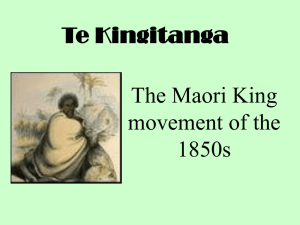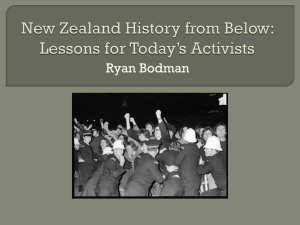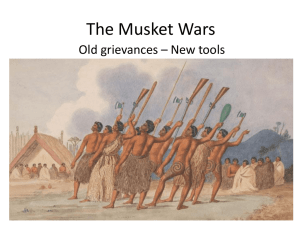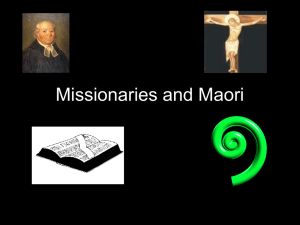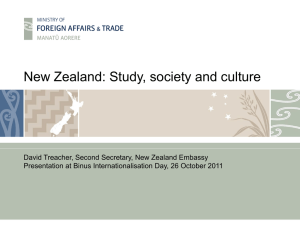The people before - Miss Thompson Media
advertisement
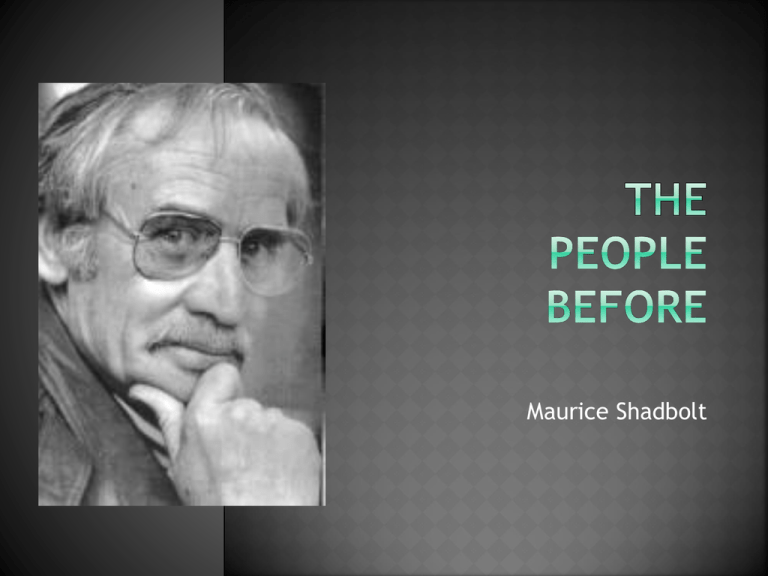
Maurice Shadbolt Shadbolt, Maurice (1932–2004), fiction writer and playwright, was born in Auckland and educated at Te Kuiti HS, Avondale College and Auckland University College. He worked as a journalist for various New Zealand newspapers and as a scriptwriter and director of documentary films for the New Zealand National Film Unit until 1957, when he left for Europe. This period of his life is recorded in One of Ben’s: A New Zealand Medley (1993). Before he returned in 1960 he published his first book, a collection of stories grandly titled The New Zealanders (1959). Although the book brought Shadbolt immediate recognition in Britain, where it was highly praised by such influential reviewers as Alan Sillitoe and Muriel Spark, in New Zealand the critical response was predominantly, and probably unfairly, negative. The eleven stories chronicled New Zealand’s social history during the first half of the twentieth century, introducing themes which have remained important throughout Shadbolt’s oeuvre. Maurice Shadbolt is a major New Zealand writer, with an impressive body of work which also includes successful non-fiction work such as the Shell Guide to New Zealand (1968). In a writing career which spanned five decades he won fellowships and almost every major literary prize, some on more than one occasion: the Landfall Prose Award in 1957, the Scholarship in Letters in 1959, 1970 and 1982, the Katherine Mansfield Memorial Award in 1963, 1967 and 1995, the Burns Fellowship in 1963, the Katherine Mansfield Memorial Fellowship in 1998, the James Wattie Award in 1978, 1981 and 1987, and the New Zealand Book Award in 1981. In 1989 he was made CBE. Above all, however, Shadbolt should be recognised for his storytelling talent. That almost all his books remain in print is testament to his enduring popularity with a wide reading public. The story is about an unnamed family who struggle to improve a dairy farm. The father has bought the farm cheap from the owners (the people before) who have not made much in the way of a farm at all. The father has watched his father work for other people all his life and he makes up his mind that he will buy land and be his own boss. During the World War I Gallipoli campaign, the father’s thoughts of owning his own land kept his hopes up at the darkest moments of the fighting. There are two sons. Jim is the younger and does not take to farming too well. He is weakish and his mother keeps him inside, whereas the older brother (the narrator of the story) loves the outdoors and is much more ‘his father’s boy.’ The father concentrates on improving the flat land for cattle and ignores the hills which he sees as a nuisance. Jim is an imaginative sort of child and explores the hill area. He finds caves and Maori adzes. His father’s interest is immediately that they might have some worth. The two brothers explore the area more and find a cave with a human skull in it. Clearly there has been some Maori occupation there at some time in the past (another set of ‘people before’). They keep the knowledge secret. The land is hard to work and often the father thinks of giving up, but pride and invested achievement keep him there. It is the time of the Great Depression 1929-1933 and the father has no time for the moanings of the city folk. A group of Maori visit the farm one day to allow the dying old father a last chance to see the land of his youth. All the tribe know every detail of the farm and the hill which was once a Pa site and saw battles with the British, ending with the Maori tribe abandoning the land: not worth any more deaths. Jim befriends the Maori group and offers the adzes which they refuse. The old Maori man is dying and the group stay the night and leave him buried on the hillside. The father is outraged and gets the police in but no-one can find the body. The father sees things differently now and senses that his efforts are insignificant alongside that of these ‘people before’. He sells up and the family moves from farm to farm. The two boys go off to World War II. On their return Jim goes to university and the older brother stays on the farm to take over from his father (‘the one before’). When they talk about the war one day, they both have the same tale of thinking about a fond moment to help them through just as their father had done in WWI. Jim tells his brother he thinks of the adzes and the burial cave and the Maori family who left their father in a grave in a cave. His older brother seems to feel cheated that his younger brother has such a fond memory of the place and seems to understand the real name of the farm: Te Wahiokoahoki, the place of happy return. 1 Describe the early farm after the father bought it ‘for a song’. Who were the ‘people before’? 2 What do we get to know about the father’s character and that of the mother and the two boys? Find some lines to quote which typify each character. 3 Towards the end of part 1, Jim goes to the abandoned hill area. He finds a cave with adzes and also a human skull. What is the father’s attitude to the adzes? What does the author hint at now about ‘the people before’? 4 This part opens with a reference to the end of the depression. What year is that, roughly? 5 In the first pages of this section explain how the father’s view of the land and his work has changed. 6 On p 206 the mother says “perhaps they’ve got happy memories of this place”. After reading Part 2, how does this statement seem ironic? 7 Describe why the Maori family have come to the farm. 8 Re-read the last ten lines of part 2. Why does the son think his father might have said or felt something else? 9 What action has completely astounded the father? 10 In what way have the brothers remained the same? 11 Re-read the conclusion to the story. Why does the older brother think that Jim has ‘beaten’ him? 1 To how many people does the title ‘the people before’ apply? 2 What differences in values do various owners of the land have? 3 What do you get to know about New Zealand farm life in the 1930’s? SUMMARY: Maurice Shadbolt is one of the towering figures of New Zealand literature, winning numerous awards and accolades for his work, much of which examines the history of the country through narrative. The central characters in this story are carving out a farming existence on the land, and the importance of land ownership to the family is made apparent in a number of phrases in the story. The narrator tells us that ‘my father took on that farm’, he refers to the importance of ‘Land of your own,’ which becomes ‘your own little kingdom’. The suggestions of the history of the land come through the discovery of the greenstone adzes and attitudes to the land are brought to the fore with the visit of the Maori group. Although Shadbolt characterises Tom Taikaka as pleasant, courteous and patient, there is the constant underlying acknowledgement of the Europeans’ displacing of the Maori from their land. Jim’s attempt at restoring the greenstone to Tom is symbolic of an attempt at restitution, and the reader is left to interpret Tom’s reluctant refusal. The return of the Maori elder to the land in death, and his disappearance, is another indication of his unity with the landscape and again demonstrates the different attitudes to land held by the Maoris and the Europeans, attitudes which remain polarised in the brothers at the end of the story. Wider reading Strangers and Journeys or The Lovelock Version by Maurice Shadbolt Playing Waterloo by Peter Hawes Compare with Journey by Patricia Grace Her First Ball by Katherine Mansfield The Enemy by VS Naipaul Online Biographical information and a critical review of Shadbolt’s work is available at: http://www.bookcouncil.org.nz/writers/shadboltm.html This newspaper obituary is also interesting: http://www.timesonline.co.uk/tol/comment/obituaries/article4 97710.ece

